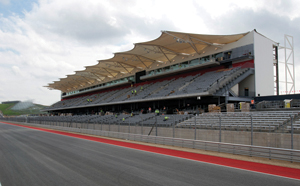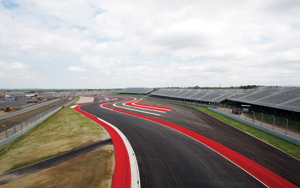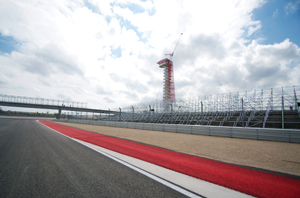One Thursday night last June, three days before the 2012 Canadian Grand Prix, the Mexican Formula One driver Sergio Perez was dining on steak and seafood in a crowded Montreal restaurant. At his table was a group of executives who wouldn’t have recognized his face only a few months earlier, or even known his name. Now, they had a vested interest in his success.
This was the delegation from the Circuit of the Americas, a $400 million, 1,300-acre racing and entertainment facility being built near the Austin, Texas, airport. One month from now, on Nov. 18, it will be the site of the first Formula One grand prix to be held in the United States since an eight-year run at Indianapolis Motor Speedway ended in 2007. But in June, construction on the track had barely begun. Labor problems had impeded progress for
much of 2011. Many of the vital staff executives had only recently been hired, six months or more behind schedule.
Some had come from Churchill Downs. Others had worked under Tom Hicks for the Dallas Stars. Almost none knew anything about auto racing. Neither did lead investors Red McCombs, who has owned NBA and NFL teams, and hedge fund tycoon Bobby Epstein.
“We’re holding their hands all the way through,” said Pasquale Lattuneddu of Formula One Management, the chief lieutenant to F1 boss Bernie Ecclestone.
What they did know was how to stage a big event, like the Kentucky Derby or the NHL All-Star Game. And as Steve Sexton, COTA’s president, set out his vision, he described a grand prix that would look less like previous iterations of the race than like a Super Bowl —
 |
Photos: CIRCUIT OF THE AMERICAS
|
or even New Orleans’ Jazz Fest. There would be concerts and downtown festivals, food fairs and video screens. And somewhere in the midst of it all, Formula One.
“The existing American racing fans are busting down the doors to buy tickets,” added Geoff Moore, COTA’s chief marketing and sales officer. “But we’re very aware of the demand for Formula One races across the globe. We’re very aware of the history of Formula One in America. For us to be successful long term, we know we need to go beyond [the existing race fan].”
That explained the presence of Perez, who drives for Sauber. While not a championship contender, he has a fanatical following in Mexico, where affluent fans have shown a willingness to travel to Canada, Europe and beyond for races. Now here was one just 225 miles from the border, a two-hour flight from Mexico City. “It’s my home track,” Perez said of a facility that at the time existed as a few steel skeletons and a big pile of mud. Moore nodded approvingly.
Related story: New Jersey F1 race 'a risk proposition'
A hundred days later, the Circuit of the Americas is nearly finished. And what began as a seemingly far-fetched idea to bring Formula One to Austin now serves as a sort of last, best hope for the sport in the United States. F1 has failed here in big markets and small markets, on street courses and racing circuits. Austin’s race, along with a street event in Northern New Jersey with a Manhattan backdrop that is on the schedule for June 2013 (see related story), but now appears in doubt, will likely be the final attempt in Ecclestone’s decades-long tenure to bring what he markets as the world’s most popular sport to the world’s biggest market.
“We’re a big deal,” Ecclestone said in June while sitting beside his luxury trailer in the paddock area at the Montreal track. “Really, there’s the Olympics, the World Cup and Formula One. We’ve made it clear in the past that if we can’t go first class, so to speak, we don’t travel. We don’t need to. What they do in Austin will be first class. They’ve convinced me of that.”
Whether they’ve convinced America to pay attention to another major event on its annual sports schedule remains uncertain. In fact, for any possible future for Formula One in the U.S., they have to get Austin to work.
■ ■ ■
For nearly half a century, spread over the American landscape from the Finger Lakes of New York to the Long Beach, Calif., harbor, the European-based sport of Formula One worked to establish a U.S. presence. The hamlet of Watkins Glen, N.Y., staged an under-the-radar U.S. Grand Prix for two decades. Las Vegas built a circuit in a parking lot. Long Beach had modest success on its city streets, but saw greater potential for profit with Indy cars.
Dallas, Detroit and Phoenix followed, but none of the races gained traction. Reasons were varied — there was the constant stress in negotiating with the ever-mercurial Ecclestone, races failed to draw the huge numbers of fans needed to make such an undertaking a financial success, and they failed to attract a sufficient television audience to make the race a network staple.
Even an eight-year run at Indianapolis Motor Speedway couldn’t penetrate the consciousness of most Americans.
It hurt that few of the drivers were American, and none of the teams. Beyond that, the U.S. domestic sports calendar was packed tight with team sports, golf and tennis, boxing — and plenty of racing.
Maybe most damaging, Formula One had no continuity in the United States.
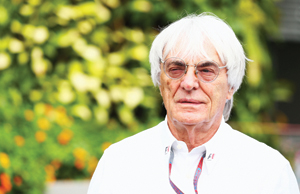 |
“We’re in show business, you know,” says Formula One’s Bernie Ecclestone. “NASCAR had 35 shows a year in America while we had one.”
Photo by: GETTY IMAGES
|
“Before, we’d pop in for one week and be gone,” Ecclestone said. “We’re in show business, you know. NASCAR had 35 shows a year in America while we had one.”
And when that one show ended each year, fans were out of luck. News and features on the series were nonexistent in mainstream publications. Other than the occasional “Wide World of Sports” broadcast from Monaco, your chances of seeing an F1 car on television were close to zero. “The Monday after each grand prix,” said Stefano Domenicali, the team principal of Ferrari, “there was no more interest in Formula One. Finito. Because there was no more information. Everyone had left town, and that was it.”
That last point, at least, has changed. Fox’s Speed channel telecasts the bulk of the series’ schedule, including qualifying sessions, with the Fox broadcast network picking up four races. The telecasts draw between 250,000 households when on Speed to up to 1 million households per race when on Fox. The current three-year contract expires after this season but negotiations are under way to extend it, a Speed spokesman confirmed.
But making an F1 race work financially is still an uphill climb, in the U.S. and everywhere else. Many F1 races in developing nations receive large government subsidies, and the reason is clear. On top of the undisclosed sanctioning fee, FOM typically owns nearly all the commercial rights at its venues, from signage to corporate sponsorships to television, radio and Internet rights. “At the race, just about all we can offer our sponsors is hospitality,” said Ben Cahalane, who leads the sponsorship team for COTA.
What makes Austin different than previous efforts — and from the New York/New Jersey model, which is scheduled to be run on a street course — is the existence of the facility as year-round inventory. “This will be a 365-day-a-year operation, and we’re going to have an awful lot there,” said McCombs, who at various times over a long career has owned the Minnesota Vikings, Denver Nuggets and — twice — his hometown San Antonio Spurs. “Formula One is our lead entity, but in the overall scheme of things I expect that to be no more than 25 percent of what we do there.”
So COTA is now focused on programming the facility, and as many as half a dozen other racing circuits are being targeted to add COTA stops to their schedules. V8 Supercars, Grand-Am and MotoGP are locked in for 2013. Even NASCAR’s Brian France publicly expressed interest in potentially staging a Nationwide Series or truck event at the track.
From there, COTA executives are talking about concerts, trade shows, a driving school, high-end auto auctions, volleyball, even tennis. Track sponsors will be buying integrated facility packages and have multiple opportunities — cut across a swath of demographics — to activate their investment. They won’t have on-track exposure during the F1 race next month, but will be able to activate off-track throughout the city.
So if the race itself doesn’t turn a profit for a few years, that’s fine with COTA. “Our success isn’t going to be determined by the Formula One race, but by the impact it has locally,” Epstein said. “We have to operate an entertainment facility year-round. The race will help us do that.”
It helps that COTA’s lead investor is a billionaire. McCombs has a profile in Texas as big as any financial heavyweight. The other member of the original ownership trio — along with former driver Tavo Hellmund, who brought the initial idea to McCombs but was bought out over the summer — is Epstein, a University of Texas graduate eager to help raise the international profile of his adopted hometown. “We’re not about to get the NBA, NFL or MLB,” he said. “This is the big leagues for Austin.”
Beyond the U.S. border, Austin remains obscure. It has no non-stop flights to Europe, and name recognition in international capitals borders on nonexistent. “We’ve made some headway, but we have a long, long way to go,” said Matthew Payne, executive director of the Austin Sports Commission. “I can’t think of anything that would help more than Formula One.”
The three days of racing is looking to draw more than 100,000 to the facility, but will be augmented by ancillary events in downtown Austin of a scale F1 hasn’t seen. Indianapolis wasn’t able to mobilize its community, largely because F1 was only the third-most-important weekend at that facility each year, behind the Indianapolis 500 and NASCAR’s Brickyard 400. Watkins Glen was too small, the Los Angeles and Dallas areas arguably too big.
But Austin has thrown its marketing muscle behind the race — with events both at the track and throughout the area. “We’re looking at 10 concerts each on Thursday, Friday and Saturday nights, at venues ranging from 1,000 to 5,000,” said Bob Lander, executive director of the Austin Convention and Visitors Bureau.
The point isn’t so much the music but establishing a big-event atmosphere that will give the race a presence in the city even for those who don’t get to the track. Lander expects 100,000 visitors to fill the city’s 30,000 hotel rooms and beyond, as far away as San Antonio, and a major corporate hospitality presence. “We’ve got a good name in technology, and IBM, Bell and Samsung have already committed to bring in clients,” he said. All of them will spend far more time downtown, where the hotels are, than at the Circuit of the Americas.
■ ■ ■
But questions remain on the event’s viability. Just last week, one month out from the race, the official COTA website had no mention of track or race sponsors. COTA is working with QuintEvents to sell its packages, and though Sexton promised that many of the city’s biggest corporate names had committed, and announcements are expected in the next few weeks, such delay means that they’ll have little time to activate before the race actually happens.
Construction on the track — a 3.4-mile circuit with 20 turns and a significant hill coming off the starting grid that could attain iconic status in the racing world — won’t come down to the wire like some previous F1 efforts, in which paving was still being done during race week. But no sign of the 30 video boards to be positioned around the track exists and electrical lines are only now being laid to power them.
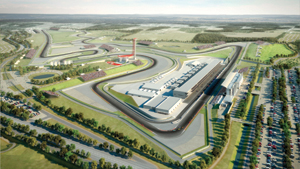 |
A rendering shows the layout of the track, which is to host an F1 race next month.
Rendering: CIRCUIT OF THE AMERICAS
|
And expectations have been downscaled. “Companies that haven’t been involved with this before are having trouble wrapping their arms around just how big this is,” Cahalane said. From an original goal of 30 percent international visitors, Sexton reports the final number is likely to be around 15 percent, below most F1 events. That figure includes nearby Mexico, which was once hoped to provide fully a third of ticket buyers. In that area, Sexton admits, the group’s expectations were overly ambitious.
COTA brought in Legends to assist on tickets sales, and as of last week, more than 100,000 three-day tickets had been sold at prices ranging from $299 to $800. There is no listed capacity for the race, and organizers are hoping to hit up to 120,000. Personal seat licenses that range from $1,500 to $5,500 and allow first crack at tickets for any event held on the track remain available.
Some onlookers do the math and can’t see how the numbers work. “Red McCombs doesn’t seem to be anybody’s fool, so I’m sure there’s a business model behind it,” said Mark Coughlin, Octagon’s executive vice president, who focuses on motorsports. “But whether it’s based on good or bad assumptions remains to be seen. From the outside, if they aren’t making money with the F1 race, then it would seem they are relying on four or five other events that will each draw 100,000 attendees. I don’t know what racing series they are going to book that will draw those kinds of crowds.”
One financial marker has already been established: the race’s local and state tax contribution to the economy. A government rebate plan called the Major Events Trust Fund, which is designed to attract top-level sports events to Texas, helps to defray costs incurred in hosting an all-star game, a Final Four … and, it turns out, Formula One. “Bernie was fascinated to hear that you can be owned and operated as a private entity and still get a subsidy from the government,” McCombs said. The trust fund will put COTA $25 million closer to breaking before the first souvenir T-shirt is sold.
Now, initial skepticism about whether the race would be run has been quelled by the pace of construction, ticket sales, and votes of confidence from Ecclestone and his team. A site inspection in mid-August by FIA race director Charlie Whiting yielded a highly favorable report. “The quality of the workmanship is excellent and I have no concerns at all,” he said.
Crucially, too, Formula One finally appears to need the United States. Having expanded to Asia and the Middle East, it now sees the absence of the world’s largest economy as a gaping hole in the opportunities it presents to its sponsors. It isn’t just Sauber looking to access the American consumer, but Mercedes, Red Bull, Banco Santander, Ferrari and beyond. “Formula One is the No. 1 sport globally,” said Force India’s Bob Fernley. “All that’s missing is the U.S. What we need to do is help Austin to make sure they do it right this time, to let each party do what it does best. There’s nobody better at putting on a show than the States.”
“F1 is very pure, the essence of motorsports,” said Sauber CEO and team principal Monisha Kaltenborn. “Something like the Super Bowl and all the show around it — we’re not used to that. So maybe it would make a very interesting combination. The U.S. flavor, a great show. If it succeeds, it could make the F1 brand even more attractive.”
What would success look like? According to Epstein, a crowd of at least 100,000, with hopes of an additional 30,000. To Moore, it’s an event that makes everyone who attended eager to return. “Success is a sold-out event after 10 years,” he said.
Octagon’s Coughlin agrees. “If they can stick with it for 10 years, I think they’ve got a great chance. But it’s certainly not going to be ‘flip a light switch and it will happen.’”
The F1 community will know success when they see it. Next month’s race will be seen as the American stop the sport has been seeking for more than a generation. Or it won’t. If it is, the benefits will extend in several directions, well beyond a financial return on investment for Epstein and McCombs. F1’s sponsors will finally complete the worldwide stage they’ve been seeking. The New Jersey event will benefit from a surge in U.S. interest in the sport.
“If Austin has the intelligence to do it right, they have a great opportunity,” Domenicali said. “If this works, it will define Austin for the world.”
Bruce Schoenfeld is a writer in Colorado.


